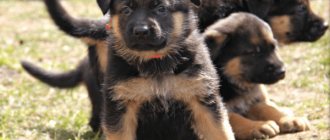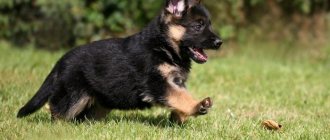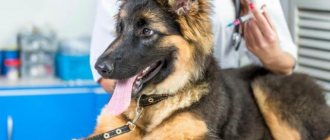If the dog is healthy, vaccinated according to age, free of helminths, and also physically active, the birth of a German Shepherd usually takes place at home without complications. Of course, if the owner is ready for them and knows what to do in unforeseen cases. Even if you are an inexperienced dog owner, the main thing is not to panic.
The German Shepherd is a social creature, and “reading” the owner’s emotions is not a myth. Prepare, consult with the breeder, keep your veterinarian’s phone number handy.
How long does pregnancy last?
The German Shepherd is a breed whose pregnancy and childbirth often occur “according to an individual schedule” - the gestation period can be different not only in two different dogs, but also differ in one (this depends on the number of fetuses). The average gestation period is 60 to 65 days. Usually:
- the first-time bitch carries longer than the one who gave birth;
- the more future babies, the shorter the gestation period;
- births that occur before 53 days after mating are premature and the litter is not viable;
- a bitch goes longer than 70 days is a danger signal; a doctor’s consultation is required and, most likely, a caesarean section.
Sometimes owners get worried, counting down the days after mating, but the birth did not come “on time.”
Please note that the day of fertilization does not coincide with the day of mating (sometimes plus a week!).
Pregnancy
Visually, signs of pregnancy become noticeable in the animal 1-1.5 months after fertilization. The female’s body takes on a rounded shape, and the belly hangs down. The nipples can be felt well. They swell and harden with the flow of milk.
However, similar signs appear during a false pregnancy. To finally make sure of the interesting situation of your pet, it is better to contact a veterinarian. He will perform a thorough examination and help determine the time of birth.
Terms and signs
German Shepherds do not have a clear regulation for the duration of pregnancy. Each dog bears offspring in individual terms, on average 60-65 days.
Long-term practice of observing purebred animals has made it possible to establish a number of patterns:
- In firstborns, pregnancy lasts longer than in females who have given birth.
- The gestation period is influenced by the number of future babies in the litter: the more puppies, the faster the birth occurs.
- Cubs born before 53 days do not survive.
- Delayed labor beyond 70 days requires surgical intervention (caesarean section).
A pregnant female noticeably changes her behavior. She becomes calmer and spends more time next to her owners. During the gestation period, the animal eats and drinks a lot. At the same time, inexperienced bitches who become pregnant for the first time often continue to lead an active lifestyle. Owners need to carefully monitor the behavior of the expectant mother so that she does not harm herself and her offspring.
Stages of an interesting situation
Normal pregnancy in a German Shepherd lasts 60-65 days. During this time, intrauterine development of the fetus occurs. It consists of several stages:
- By day 21, the heart is formed.
- By day 27-28, the body takes on a full-fledged appearance, but without hair.
- By day 32, 25% of the required body weight of the fetus is achieved. At this time, it is recommended to do an ultrasound.
- By day 34, a stable skeleton is formed.
- By day 37, the formation of the main organs and systems ends.
- On day 45, you can accurately determine the number of cubs (video author Anna Fedorchuk).
How many puppies can a German Shepherd have?
On average, a purebred German Shepherd at fertile age gives birth to 6-8 babies (it has 5 pairs of full-fledged nipples). A female's first litter may contain 5-6 puppies. But it all depends on the individual characteristics of the dog’s body: the number of litters can vary from 1 to 14.
If your German Shepherd is already a "venerable matron" from 6 years old, the norm for her will be 1-3 cubs, even if she previously gave birth to more.
Rules for preparing for mating
A female German Shepherd reaches physiological maturity at the age of 6-9 months. However, it is not recommended to breed a female dog when she is in her first heat. Experienced breeders advise mating at the time of the dog’s third sexual cycle.
When pregnancy occurs earlier than expected, the risk of sick or dead puppies being born increases.
When preparing for mating, the search for a male dog should be carried out by the owner of the bitch. The choice of candidate is determined by several factors:
- breed;
- lack of family ties with the female (if there are even distant ties, puppies can suffer from congenital diseases).
The preparatory stage should begin a month before the process. During this period, dogs must undergo deworming. It is also necessary to eliminate skin parasites and get preventive vaccinations.
Experts recommend breeding dogs only through a breed club or kennel.
In this case, breeders independently select a healthy pair for the female. Attention! Mating with an unfamiliar and untested male can lead to infection with parasites and transmission of sexually transmitted infections, which, in turn, will provoke the development of other pathologies.
Caring for a pregnant bitch
Walking a German Shepherd until mid-pregnancy is no different from usual: physical exercise is not only acceptable, but also useful (sedentary and obese animals give birth much more difficultly - just like people). The main thing is not to overwork the expectant mother and avoid stressful situations during walks: aggression from relatives and people, fights, fear. Walk peacefully!
The food for a pregnant German Shepherd is special - if you feed it with ready-made food, switch to a special one for pregnant women. If straight, then:
- porridge and stew are not needed;
- more protein foods and vegetables.
Vitamins are a must, especially calcium - puppies need a “base” to build and strengthen their bones and teeth, and if there is no additional source of calcium, your dog’s bones and teeth will become weak.
From 4 weeks of pregnancy, feed the bitch three times a day, from 7 weeks - four times. Do not overfeed, regular portions are simply divided into three and four times!
A week before giving birth - exclude raw fish and meat, more calcium and sunlight, in order to prevent eclampsia during labor and titania after it ends.
Physical state
Several obvious signs can indicate future birth.
External moments
Firstly, a month before the start of the process, the pregnant shepherd's belly becomes rounder. Secondly, within three weeks the genital organ swells and discharge appears. Thirdly, within two weeks the nipples begin to swell. Milk appears two to three days before birth.
From the fifty-seventh day, periodically measure the shepherd's body temperature, morning and evening. The normal temperature for a dog is 38.5 degrees, but if you notice that it has dropped by two degrees, you should know that there is no more than a day left before the offspring appear.
If the temperature has dropped, but there are still no contractions, then you need to urgently consult a specialist. This must be done if the German Shepherd has an increase in temperature, which threatens the birth of dead puppies.
Changes in behavior
The closer the birth is, the more noticeable are the changes in the psychological state of the German Shepherd. A week before the birth of her puppies, the dog begins to get nervous and prepare a place where she drags her favorite things.
She may begin to refuse to eat or eat selectively. In this case, divide the daily diet into small portions and let her eat little by little, being sure to check the condition of the stool. If you notice that the feces have turned yellow or dark green, with a bad and pungent odor, immediately take your shepherd to the vet. Be sure to report how long it has been since your last meal.
Diet
A few days before the onset of labor, you need to remove raw meat, fish and almost all salt from your diet. Otherwise, there is a risk of provoking eclampsia - a severe process of toxicosis, which can develop due to poor functioning of the liver and kidneys. Signs of eclampsia are swelling, cramps, and a sharp rise in blood pressure.
Dog behavior before giving birth
A German Shepherd before giving birth - even at the beginning of the first month - sometimes becomes inactive and seeks the owner's attention. As a rule, her thirst increases. Somewhere in the 4th week of gestation, the bitch begins to consciously avoid excessive activity during walks. Young, inexperienced German Shepherds, who have never given birth, remain hyperactive and playful - here the owner needs to intervene and not allow the expectant mother to “set records.”
What are the signs that indicate an impending birth?
By watching your German Shepherd as a puppy, you can notice the signs of labor in time and prepare for them. Among the main symptoms:
- sagging abdomen;
- stopping the puppies from moving;
- change in nipple color and swelling;
- colostrum secretion;
- drop in body temperature;
- vomiting or diarrhea;
- increased heart rate;
- removal of the plug;
- first, not very frequent contractions in the form of uterine contractions;
- discharge of amniotic fluid.
False pregnancy
Be careful: if estrus has passed, there was no mating, but at 5 weeks after estrus the bitch begins to produce milk - this is a hormonal surge that led to a “program failure.” There is no pregnancy, but the dog:
- begins to show frantic activity in preparation for childbirth - “builds a nest” (usually from anything);
- depicts a loving mother for your slippers, soft toys, items of clothing;
- aggressively protects the lair and fake children;
- “from nerves” he stops eating normally.
She's not crazy - it's a false pregnancy. This condition can occur after mating, but only when the fruits have died and dissolved (usually at about 4 weeks). “Dummy puppies” need to be removed so as not to aggravate the condition - but be prepared that the “unfortunate mother, deprived of children” will begin to look for them everywhere in the most active way - she may rummage through beds and closets.
False pregnancy is not dangerous - the milk that appears is dangerous. Its stagnation can lead to mastitis. Contact your veterinarian.
Caring for a shepherd dog and puppies after birth
A caring mother will do everything to ensure that her offspring grow up healthy, and the owner is required to create conditions that can ensure the full growth and development of puppies. To do this you need:
- Change the litter regularly.
- Ensure a comfortable temperature in the area where the dog and puppies are located.
- Transfer babies who do not have enough breast milk to artificial feeding.
- Trim the nails regularly to avoid injuring the abdomen.
- Eliminate all sources of injury around the nest.
- Start complementary feeding at two weeks.
Place for birth
Your animal is large and cannot give birth in a basket. You should prepare a crate in advance for a calm birth of your German Shepherd. The size of the “rodbox” is desirable so that the dog can easily fit in a lying position and can, lying on its side, rest its paws on its wall (many German shepherds do this during labor).
The box must be washable and not absorb odors. Lay oilcloth on the bottom and bedding on top. You need an open wall or a removable side - it’s hard for the expectant mother to take the barriers, and it’s easier for you to clean the “rodbox”.
Many people do not see the need to introduce the bitch to her “ward” in advance - this is a mistake. Arrange her there at least 10 days before delivery, otherwise at a crucial moment she may not like this “surprise”, and she will give birth where it is convenient for her, but not for you.
Keeping a pregnant dog
While the German Shepherd is pregnant, she is provided with careful care and maintenance. In the first month, food and physical activity are not limited. Make sure that the dog does not come into contact with stray animals, does not lie on a cold floor or wet grass, since during this period it is vulnerable and susceptible to infectious diseases. They regularly carry out hygiene procedures, care for the coat, walk, bathe and feed.
Feeding
The puppy's diet is changed after 35 days. If she was given industrial food, select special food for pregnant women, lactating women or for puppies. If the food consisted of natural products, their volume is increased by half and the bitch is transferred to three feedings a day. Add cottage cheese, kefir, carrots, apples, veal, buckwheat, rice and quail eggs to the diet. Your veterinarian will be able to select the required vitamin supplement. It should include calcium, phosphorus and vitamins C, D, E.
Walking outside
Despite the fact that the bitch is bearing offspring, active training with her must be continued until the third week of pregnancy. Even if the female is stubborn and capricious due to hormonal imbalances, the load is not reduced. From the fourth week, they walk the dog after each feeding. Walks last 30-50 minutes, with a gradual decrease in the intensity of exercise.
Bathing
Hygiene procedures for a German Shepherd should be carried out in the usual manner for it. Swimming is acceptable in the second half of pregnancy, but with precautions. Use warm water and dry the hair thoroughly after the procedure. Immediately before giving birth, hairs near the nipples and vagina are cut off in long-haired species.
How to determine when labor is approaching
It is not difficult to see the signs that labor is approaching. Your German Shepherd:
- fidgets, worries;
- whines;
- tries to hide or, on the contrary, follows you, as if asking for help;
- breathes quickly, as if from the heat;
- sits down, arching his back;
- her heartbeat is “fast”;
- her pupils dilate;
- the rounded belly “falls off”, the bitch has sunken sides (this sign does not appear in firstborns);
- a plug of mucus comes out of the vagina.
Measure your dog's body temperature - it should be 1.5 °C below normal. You can’t say anything about your appetite: one woman in labor refuses to eat, another chews until the very birth.
If the dog lies down and pushes, the process has begun!
At what age are German Shepherds mated?
The German Shepherd reaches sexual maturity at 6-10 months, when it begins its first heat. At the same time, the dog continues to grow and develop. The ideal age for the first mating is 18-22 months, which falls on the third heat.
Transferring it to an earlier date threatens a lot of problems - disturbances in the development of the genital organs, complications with the spine and physique, few offspring and early aging of the dog.
The latest date for breeding a bitch is 4 years. At an older age, her hip joints lose extensibility and flexibility, metabolic processes are disrupted and excess weight is gained.
Under the strict supervision of the breeder, mating of a healthy dog is possible up to the age of 10 years, provided that time is allowed for recovery.
How does childbirth occur in a shepherd?
The birth of a healthy German Shepherd usually lasts 3-15 hours, sometimes dragging on for a day. Labor begins with contractions, continues with pushing, and just before the baby is born, the water breaks. The bitch frees the baby from the membranes, gnaws the umbilical cord, and licks it. The next one should appear soon - sometimes literally in a couple of minutes, sometimes it takes up to an hour.
Normally, human intervention is not required, but today's breeding of the breed, unfortunately, does not guarantee the absence of behavioral deviations.
Shepherd gestation duration, periods
Pregnancy in a female German Shepherd lasts approximately two months. During this time, the dog owner should fully concentrate on the condition and well-being of the pet, surround it with attention and affection. The dog needs to be provided with the necessary care, as well as the correct feeding regimen. Fluctuations in the duration of a dog's pregnancy are explained by the difference between mating and the ovulation period.
Main periods:
- the first stage is the fourth week of pregnancy. There are no changes in the dog’s usual lifestyle or signs of pregnancy, but lethargy and a feeling of thirst are possible. The diet does not change. When feeding twice a day, preference should be given to such healthy foods as raw meat, boiled liver, cottage cheese, porridge cooked in milk, grated vegetables with herbs and a small amount of refined vegetable oil;
- the second stage is from the fourth to the sixth week of pregnancy. It is imperative to consult with a veterinarian, who will determine the number of puppies to bear and give general recommendations for care. The number of feedings increases to three times a day. The standard diet should be supplemented with a significant amount of meat, cottage cheese and fish, liquid milk porridges and a variety of soups with meat broth. At the end of the second month, you need to double the amount of mineral supplements;
- the third stage is from the sixth to seventh week of pregnancy. At this stage, it is necessary to reduce the total duration and number of active walks, as well as completely abandon heavy physical activity. You need to add a couple of tablespoons of bone meal per day to your diet. It is very important to control the dog’s weight and prevent obesity, which complicates the process of future childbirth;
- the fourth stage is from the seventh to the eighth week of pregnancy. At the end of the seventh week, there is noticeable movement of the fetuses in the dog’s womb. It is necessary to prepare a place for future births, which will allow the animal to get used to its location. The corner designated for this purpose should be located in a warm and dry place, without drafts. The dog should be fed four times a day, with standard prevention of constipation and the mandatory introduction of a sufficient amount of calcined cottage cheese. Walking time should also be limited and swimming in reservoirs should be cancelled;
- the fifth stage is from the eighth to the ninth week of pregnancy. A drooping belly prevents the dog from walking for a long time and puts pressure on the bladder, so walks should be short, but quite frequent. The animal may lose appetite and drink a lot. It is necessary to replace any meat with boiled fish in the diet, which will eliminate the occurrence of toxicosis.
About a day before the onset of labor, the German Shepherd refuses food, begins to periodically whine and can behave extremely restlessly.
This is interesting! The timing of pregnancy directly depends on the age of the German Shepherd, these indicators in its mother and the timing of the previous pregnancy.
A few hours before giving birth, the body temperature drops a couple of degrees, and heavy breathing appears. For the purpose of delivery, the dog must be taken to a previously prepared place.
Return to content
How to deliver a baby
Monitor the progress of the birth process to prevent possible difficulties:
- normal canine birth - lying or standing. Is the dog sitting down? Raise it on your hind legs - or the fruit will be crushed;
- the water broke, after 2 hours the fetus has not left the birth canal - a dangerous situation, there is a possibility of asphyxia, and the dead fetus will block the birth canal. Call a veterinarian immediately;
- after the birth of each puppy, the bitch gives birth to a placenta - be sure to ensure that the number of placenta is equal to the number of babies born; if the placenta remains inside, inflammation of the uterus (endometriosis) is inevitable;
- The bitch usually eats placenta - but it is not advisable for her to consume more than 2-3 pieces in order to avoid digestive upset. Try to remove the unnecessary ones.
If the next puppy was born an hour and a half to two hours ago, and the mother’s belly “sinks” and becomes soft, labor is completed.
Start of the process
Just before giving birth, the behavior of a German Shepherd changes dramatically - it withdraws, whines, and scratches its bedding. She lies down for as long as it takes before giving birth, eats nothing and breathes quickly. At first glance, you can notice the dog’s muscles trembling, and you can see the puppies moving in the womb.
If you have prepared the maternity box well and thoroughly and will be around as long as needed, then all these manipulations will help the shepherd get rid of unnecessary nervousness.
The birth process itself can be divided into three parts:
- before childbirth;
- birth of puppies;
- after childbirth.
Before birth
Muscle contractions in the uterus - the process of contractions - can last up to thirty hours. Due to frequent contractions, the cervix begins to dilate, which is not noticeable from the outside.
Birth of puppies
The cervix opens fully and contractions and pushing - contractions of the abdominal muscles - help the fetus move through the birth canal for subsequent birth.
As soon as the puppy is born, the mother herself bites off the umbilical cord and begins to lick her baby, thereby stimulating it to life. Do not rush into the birth of the first fetus; you will only harm both the puppies and the shepherd dog on your own. Give as much time as necessary for a natural birth. A German Shepherd can give birth to an average of seven puppies.
After the birth of a puppy, an afterbirth comes out which the dog eats. It contains extremely important substances for the continuation of normal childbirth and the appearance of lactation. To maintain health, two afterbirths are enough; do not let your dog eat more, otherwise he will develop diarrhea.
Try to change the bedding for the shepherd's comfort as often as possible.
How long?
Normal birth lasts up to twelve hours, the interval between the appearance of puppies is on average an hour. If more than two hours have passed since the birth of the last baby, this means that labor is over. But sometimes the last puppies are born several hours later. It is normal for a German Shepherd to give birth to seven puppies.
The last afterbirth may come out within an hour. You can give your German Shepherd an injection of oxytocin. Thanks to the medicine, the afterbirth will come out quickly and easily.
After labor is over, there may be green discharge or bleeding. Why is the discharge green? Hemoglobin may turn this color due to hematomas formed in the placenta. After seven days, the discharge becomes clear and will stop within a month.
Helping puppies during birth
If the puppy’s exit from the birth canal is difficult (“neither here nor there”), you can help him very carefully: fix the part of the puppy’s body that has already appeared with two fingers and lubricate it with sterile Vaseline. With the rhythm of pushing, help the fetus come out.
If after the first cub the bitch is “confused” (happens with firstborns) and is inactive, free the puppy from the bladder yourself, cut the umbilical cord 3 cm from the abdomen with sterile scissors, wipe the mucus with a swab of sterile gauze from the muzzle so as not to clog the nose and mouth, give a massage abdomen with a damp swab, wipe the anus (if it is stained with meconium). And put it under the mother’s muzzle - let him sniff and lick it. The “ready” puppy should be placed in a separate box on a warm diaper so that the bitch does not injure him during pushing.
Apply the babies to the mother's nipples one after another - for immunity they need antibodies from colostrum. Newborn puppies must be protected from hypothermia.
Be careful: if the bitch behaves “aggressively” - crushes the puppies, tries to gnaw, licks the newborn’s belly too hard, even biting - immediately take the puppies and send them to a box with a heating pad separately from the mother. This will require artificial feeding (it is optimal to find a “foster mother” - another nursing bitch who can feed other people’s cubs).
Your help
Always be ready to come to the aid of your pet if something suddenly goes wrong during the birth of the offspring. If the fetus gets stuck, you will have to pull the babies out yourself.
The puppy walks with its head
Depending on the rhythm of contractions and attempts, gently and slowly pull the puppy by the head and paws, gently rocking him from side to side. You can easily straighten your baby's bent paws with your index finger.
If you pull too harshly and too hard, you can damage your puppy's spinal cord.
The puppy walks with its hind legs
In this case, you should hurry, otherwise the puppy may suffocate from being squeezed by the umbilical cord. Pull his tail and hind legs.
If the birth canal is too dry, immediately lubricate it with medical Vaseline using a syringe.
Other help
It is worth notifying your veterinarian in advance what time your dog is scheduled to give birth, so that he has the opportunity to come at your request.
The German Shepherd gets tired during labor. Let her eat from time to time - pre-prepared warm meat broth will do just fine. If that doesn't work, try taking her out for a short walk to relieve herself. In this case, do not forget to take a towel with you - a shepherd dog can give birth during a walk.
Help for kids
If your dog is giving birth for the first time, she may not know what to do with her puppies. Perhaps the shepherd is so tired that she does not have time to help her babies. You will need outside help.
Quickly and gently release the puppy's membranes, using a gauze swab to remove mucus from his mouth and nose. Then lift the umbilical cord so that the vitamin-rich liquid in it flows back out. After retreating two centimeters, tie the umbilical cord with a special thread. After these manipulations, dry the puppy with a towel and massage to stimulate blood circulation and breathing.
It's time to place the newborn on the mother's nipples and wait for the puppy to start eating. After all, it is in the first hours of its life that the puppy absorbs a large amount of antibodies from its mother’s milk. After the baby has finished eating, wrap him in a dry towel and place him in a separate box in front of his mother.
If the puppies are already born, but the shepherd dog still does not have milk, then feed them with pre-prepared goat milk from a pipette.
Dog behavior after birth
In experienced German Shepherds who have already given birth, milk appears a week (sometimes earlier) before birth, in firstborns - right before or during it.
Normally, the German Shepherd is an overprotective mother and does not strive to leave her offspring for a long time; if the walk, in her opinion, is prolonged, she rushes back to the kids.
Inexperienced or nervous bitches sometimes experience a reaction of dragging the litter - as if the bitch is trying to hide the children away from prying eyes. If the dog does not calm down and continues to carry the puppies, move his crate; perhaps he is not happy with its location. Sometimes a walk and refocusing helps.
Further actions
Giving birth to a dog at home involves caring for it for several days.
- When the cubs are born, the mother in labor washes her genitals with warm boiled water to prevent infection.
- The dirty bedding is removed and replaced with a clean cloth. Cotton fiber material is best.
- In the room where the whelping bitch and her babies are located, a stable thermal regime is maintained at +28C.
- Immediately after giving birth, the female must be taken for a walk, but her stay on the street should not be prolonged. The mother must return to the babies in time and start feeding them.
- If there is not enough milk in the nipples for everyone, then newborns are fed artificial infant formula.
Have you ever delivered a dog? Dog shows on the zooprtal website
A lot of interesting things on the RKF website
Illnesses after childbirth
Observe the behavior of the “mommy” immediately after childbirth, so as not to miss the symptoms of postpartum shock or titania. Postpartum shock occurs in first-time bitches: this is truly a state of shock, the dog’s behavior reads like: “What kind of nightmare happened to me?!” This condition is dangerous because an inexperienced mother may try to eat the “irritating factor” - the puppies. If you notice such attempts, stay close and keep an eye on the kids. If the bitch does not eat the offspring during the first day, this most likely will not happen in the future.
If the dog “can’t find a place for itself” - moves away from the puppies, moves chaotically, as if in fright, jumps up and tries to lie down, trembling and convulsive movements are noticeable, the animal has rapid breathing and saliva leaks - these are signs of titania. The “dark state” can last for hours, sometimes for days. The dog does not eat (and does not go to the toilet). Wrap her up, try to calm her down - and contact the vet!
Old publications recommend giving injections yourself. Back then there were problems with emergency veterinary care, but today there are none. Don't take risks - a nervous bitch may react inadequately to your medical initiatives.
How to determine whether a German Shepherd is purebred or not?
It has already been said about the ears, structural features, tail and training features, we can add that:
- The nose is large and black in color;
- Concentrated gaze;
- Paws are smooth, large;
- There are no black spots on the chest;
- The richer the eye color, the more likely it is that the puppy is purebred;
- The taste is scissor-like.
Interesting materials:
How many Scovilles are in Tabasco sauce? How many layers does the earth's crust include? How long do front brake pads last? How many people serve under contract in the Navy? How many serve in the army in Belarus 2022? How long did you serve in the army in Rus'? How long does a gas lift last? How many cm is the iPhone 5s screen? How much did Monatic raise at the Olympic Stadium? How long does it take for metal primer to dry?
Further care
At the end of the birth process, you should carefully wash the “female organs” of the “woman in labor” so that there is no irritation of the mucous membranes, and wipe it well, then take her for a walk. It’s a good idea if during the walk one of your relatives or your assistant cleans the rodbox by changing the bedding. Cotton is optimal for replacement bedding: easy to wash, quick to dry. Other fabrics are not so hygienic.
There is a misconception that newborn puppies do not need care: “the dog will do everything on its own.” She will do a lot, but she will also need from you:
- monitor the air temperature in the “birth block” (it should be at least 28°C) and the cleanliness of the bedding;
- Take care to remove dewclaws from puppies - this is a must; in the future, both the dewclaws themselves and the claws on them that do not wear off will cause injuries;
- track the process of titanium: stronger and more active puppies often push weaker ones away from the nipples, and they weaken even more. In such a situation (also with a large litter), it is necessary to transfer the malnourished to partial “artificial feeding” - supplementary feeding, goat’s milk is suitable;
- trim the baby’s claws to avoid injury to the belly; if the nipples are cracked, lubricate them with healing oil;
- When the puppies open their eyes, you need to track their movements - they will be drawn to “travel”, exploring their surroundings. Eliminate all likely sources of injury;
- from two weeks of age, introduce complementary foods for adults (if you feed dry food, for puppies).
Before two months of age, it is not recommended to separate puppies from their mother, much less sell them. From 2 months, babies are gradually introduced to regular food.
“Shepherd owners” are lucky with the breed - a healthy dog usually does not require much trouble during childbirth (there are breeds whose labor is complicated due to body type or typical genetic health problems). With an attentive and loving owner, even in the case of a difficult birth of a German Shepherd, everything ends well: the main thing is timely and professional assistance. Do you remember your veterinarian's phone number?
Basic preparation
Each dog has individual characteristics, so childbirth can take place differently. If a shepherd gives birth to puppies for the first time, then she will definitely need your help. If she already has experience, then most likely you will only have to watch the miracle of birth.
If you doubt that the birth will go well, it is better to consult a veterinarian in advance and agree that he will also participate in the process.
Preparing things
Whatever happens during the birth of your pet, prepare in advance for possible situations. Prepare a set of items near the birthing box that may be needed to help during childbirth:
- towels;
- sterile wipes;
- disinfectant solution for instruments;
- hand sanitizer;
- cotton wool;
- syringes;
- medical Vaseline;
- disposable medical gloves;
- iodine;
- oilcloth;
- heating pad;
- puppy box;
- scales;
- scissors;
- sterile raw threads;
Before the birth of the litter, it is a good idea to have a special notebook to write down all the necessary information about the litter - the time of birth of each puppy, gender, weight, all possible individual characteristics of each of the puppies. This notebook can be used as a future diary for monitoring the psychological and physical development of the litter.
After giving birth you will need the following things:
- multi-colored threads to represent puppies;
- goat milk;
- meat broth to maintain the shepherd's strength.
Prepare plenty of drinking water - you may need it at any time.
Hygiene before the process
Before giving birth, carefully wipe your German Shepherd with soapy water, remembering to thoroughly rinse off the foam with warm water. Then you need to treat the vagina and external genitalia with a weak solution of furatsilin.
Don't forget to trim your nails, wash your hands thoroughly with soap and wipe with rubbing alcohol. These manipulations are necessary in case your help is suddenly needed.
Diagnosis, signs of pregnancy
Miniature Shepherd (German mini dog)
During the first half of pregnancy, the dog does not change in appearance. The pet's behavior may change slightly; it becomes lethargic, tries to be alone, and is not happy about long walks. It is difficult to visually determine fertilization in an animal. You need to take your dog to a veterinary clinic, where they will conduct a blood test for the hormone, which will show whether pregnancy has occurred.
What does a pregnant shepherd look like?
In the first 3-4 weeks of an interesting situation, the animal may become drowsy and require more food and water. In the second month, the expectant mother is actively gaining weight, her sides are rounded, and her belly sags. The female becomes slower and shows more affection.
Feeding shepherd puppies
You can start feeding the puppies at the moment when you notice a decrease in their daily growth and they become restless, whine and try to crawl. It is important to adhere to deadlines here - haste is just as dangerous as delay. If you start feeding too early, the mother's milk production, which is a source of vitamins and antibodies to various infections, will be reduced. In fact, mother's milk is the best serum that protects the litter from various types of infections.
Usually they start feeding babies on the fourteenth day. In cases where the shepherd has problems with lactation, you can start on the twelfth day. You can give cow, sheep or goat milk by mixing egg yolk and powdered milk into it.
A bottle with a nipple is suitable as a feeding tool - the hole should be of such a size that the milk does not flow, but drips. The frequency of feeding in case of insufficient lactation in a bitch is every three hours, in case of normal lactation - three times a day.











